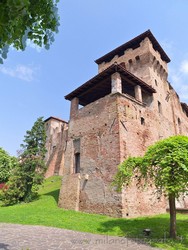|
Romano di Lombardia (Bergamo, Italy): Fortess
|
|
|
Show an other place around Milan worth a visit: |
 The Fortess of Romano di Lombardia was built at the end of the twelfth century, it is of dimensions comparable to that of the more famous Fortess of Soncino, although a little smaller and no longer equipped with an independent ravelin like that. The Fortess of Romano di Lombardia was built at the end of the twelfth century, it is of dimensions comparable to that of the more famous Fortess of Soncino, although a little smaller and no longer equipped with an independent ravelin like that.
The fortress was used from the 13th to the 18th century as a defensive military building: in it there were the lodgings of the troops, the ammunition depots, the food depots, the chapel, the prisons and the representation Room. For short periods it was also the home of some local Lords, including Bartolomeo Colleoni, who made some changes, improvements and embellishments.
In it it is possible to recognize more architectural overlaps dating back to different periods, ranging from the twelfth to the eighteenth century.
The fortess has a single entrance which is accessed by a masonry bridge, which came to replace the original drawbridge. Beside the entrance there is still the pusterla (small door for people on foot) now walled up. Outside the drawbridge in ancient times there was the defensive system complex comprehending the northern gate of the village (Porta Bergamo) with its pusterla, the ravelin, the tower of the drawbridge.
Then there was also an emergency bridge, towards the countryside, right on the opposite side to the main entrance.
The walls have a Ghibelline crenellation, although due to the succession of dominations some sections have Guelph adaptations.
Originally the fortress was surrounded by a deep and wide moat, which was filled with water from an internal resurgence and which therefore could in no way be drained by enemies. It is only after the lowering of the groundwater level that the moat became a meadow.
Originally there were two courts: the "Corte Grande" (Large Court) and the "Corte della Cancelleria veneta" (Court of the Venetian Chancellery) (or "Corte delle Prigioni", Court of the Prisons, because the prisons overlooked it). The two courts were connected and a well was between the two. In the nineteenth century a wall was erected between the two courts that incorporated the well.
The inner courtyard you come across from the entrance is the Corte Grande. A sixteenth-century stone balcony surrounds the courtyard on three sides; above it there are some trilobate fifteenth-century windows from the Colleone era (Fig. 2). In ancient times the court was perhaps completely frescoed. Only a small part of these frescoes have reached our days. Among them, in particular, a beautiful lion of San Marco with the book open under a paw, to symbolize the domination, welcome, of the Republic of San Marco over the town.
The four corner towers of the fortress are all from different eras. Looking at the entrance, on the left there is the oldest tower (Fig. 5), built in the thirteenth century, during the communal period. On the right, the high fourteenth-century tower, built by the Visconti and modified by the condottiere Bartolomeo Colleoni with the addition of corbels and machicolations to the top. A third tower rises in the south-west corner, also built in the fourteenth century by the Visconti, modified in the following century with the addition of machicolations and corbels. The battlements are of the so-called Ghibelline type, or swallowtail. Beyond the tower towards the outer moat, you can see the battlements of the primitive castle incorporated in the fifteenth-century loggia above.
The fourth tower, architecturally more modest, was built only in the seventeenth century over an earlier tower.
On the ground floor the rooms were used as a weapons depot, cellars and stables. The living quarters were on the first floor; in the east wing (above the entrance) there were the guardhouse and the dormitories of the soldiers; their kitchen and dining room were on the floor below. In the south wing the reception rooms with the large room, with a fifteenth-century wooden ceiling and decorative fresco decorations. In the south-east corner, inside the ancient tower (very interesting in its late-Gothic architecture with slender ribs) there is the ancient chapel of the castle, whose altarpiece is currently preserved in the parish church. The great hall and the chapel house the exhibition rooms of the Memory Museum of the Community of Romano di Lombardia which collects documents relating to the war vicissitudes of the war dead, the fighters and the veterans of Romano.
The western wing of the castle was reserved for housing for the castellan. In the first two centuries these environments were extremely sober; it was Bartolomeo Colleoni who, in the middle of the fifteenth century, gave hand to embellishments in order to make the residence worthy of temporarily receiving his family.
The beautiful external loggia on the south-west side was decorated with floral decorations by the Veneto Podestà Andrea Malipiero between 1484 and 1487.
The reason why the Fortess of Romano di Lombardia is not as famous as its counterpart of Soncino probably consists in the fact that in this one of Romano the interiors have been completely modified. Except for a small room to the left of the entrance, originally the castle's emergency prison (Fig. 4).
Categories: Places of historical value of artistic value
Piazza della Rocca, 3A, 24058 Romano di Lombardia BG |
Further pictures of Fortess in the section Photography |